This article has been reviewed according to Science X's editorial process and policies. Editors have highlighted the following attributes while ensuring the content's credibility:
fact-checked
proofread
Unveiling the future of nanostructures with soft matter magic

As traditional top-down approaches like photolithography reach their limitations in creating nanostructures, scientists are shifting their focus toward bottom-up strategies. Central to this paradigm shift is the self-assembly of homogeneous soft matter, a burgeoning technique with the potential to produce complex nano-patterns on a vast scale.
These intricate patterns serve a purpose far beyond mere aesthetics; they are pivotal in unlocking advanced metamaterials capable of manipulating light and sound in ways previously unimaginable.
In a review article published in the Chinese Journal of Polymer Science in March 2023, researchers from the South China University of Technology provided an extensive overview of the advancements in complex spherical packing superlattices. This comprehensive collation of research insights reveals the broad spectrum of opportunities that these advancements in complex spherical packing superlattices may unlock for transforming our technological horizon.
Central to their review is the detailed examination of methods used in the manipulation of homogeneous soft matter, specifically highlighting the processes that enable flexible molecules to self-organize into pre-defined, highly structured superlattices.
By analyzing various approaches to adjust the interaction conditions of these molecules, the authors discuss the engineering of a diverse spectrum of thirteen superlattices. These range from simple, densely packed structures to more elaborate and complex configurations, illustrating the advanced organization seen in cutting-edge materials.
The review emphasizes the methodical control achieved over the assembly process, leveraging the hierarchical nature of soft matter self-assembly and optimizing volume asymmetry alongside the strategic use of giant molecules. The discussed approaches have facilitated the formation of an array of superlattices, including the simple body-centered cubic (BCC) lattices and the more intricate Frank-Kasper and quasicrystalline phases.
Professor Stephen Z. D. Cheng, a contributing researcher to the review, remarked, "Our comprehensive analysis not only synthesizes new scientific concepts in the realm of supramolecular crystals but also consolidates the foundational principles for creating metamaterials. The insights into controlling and manipulating light, sound, and other physical behaviors through these materials are pivotal for various industries."
This review underscores the capability of soft matter self-assembly to produce nanostructures, previously achievable only with metal alloys, potentially leading to transformative technological advancements. It advocates for the advancement of bottom-up fabrication techniques, enabling the creation of materials with unique properties and fostering innovation in future technological developments.
More information: Yuchu Liu et al, Spherical Packing Superlattices in Self-Assembly of Homogenous Soft Matter: Progresses and Potentials, Chinese Journal of Polymer Science (2023). DOI: 10.1007/s10118-023-2976-5
Provided by TranSpread


















